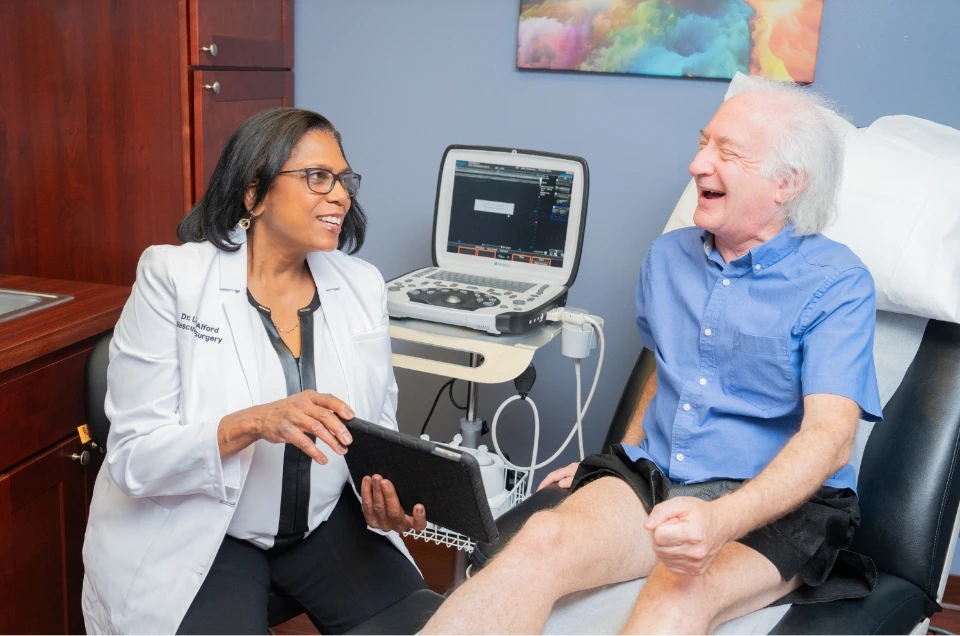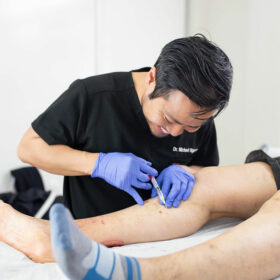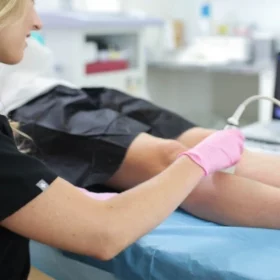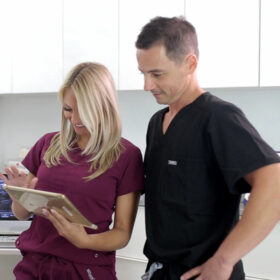Most people are now familiar with wearable technologies like the Apple Watch, Fitbits, and other fitness trackers. These devices use advanced tracking technologies to measure blood pressure, heart rate, pace, lifestyle habits, sleep, and other factors. Wearable techs also have the potential to improve vascular health. While they can’t replace minimally invasive vein treatments for conditions like varicose veins and spider veins, they can be a good means of tracking your health and making the lifestyle changes necessary to improve your vein health.
At Vein Treatment Clinic, we use the latest technologies to help you address your vein conditions and improve overall vascular health. Please continue reading to learn about how wearable technologies benefit vein health and the most effective minimally invasive treatments for conditions like varicose veins, spider veins, and venous insufficiency.
What is Wearable Tech for Vein Health?
Wearable technology for vein health represents a cutting-edge approach to monitoring and managing venous conditions. These devices combine modern technology with the necessity of proactive healthcare. Specifically tailored for the vascular system, these wearables use advanced sensors, data analytics, and connectivity features to provide a comprehensive understanding of vascular well-being.
How Does Wearable Tech Benefit Vein Health?
- Monitoring: These devices can continuously monitor key indicators such as blood flow, oxygen levels, and activity levels, providing valuable insights into vein health status.
- Early Detection: By detecting subtle changes in vein health metrics, wearable tech enables early detection of potential issues, allowing for timely intervention and preventive measures.
- Personalized Insights: Wearable devices generate personalized data that allow individuals to make informed decisions about their lifestyle, activity levels, and vein health management.
What Types of Wearable Tech are Available for Vein Health?
- Wearable Pulse Oximeters: These devices measure oxygen saturation levels in the blood, providing valuable information about circulation and oxygen delivery to the veins.
- Compression Garments with Sensors: Innovative compression garments equipped with sensors can monitor pressure levels and provide feedback on the effectiveness of compression therapy for vein conditions.
- Activity Trackers: While not designed for vein health, activity trackers such as fitness bands can still offer insights into overall activity levels, which indirectly impact vein health.
How Accurate are Wearable Devices for Vein Health Monitoring?
The accuracy of wearable devices for vein health monitoring varies depending on the type of technology and the specific metrics being measured. While some devices offer medical-grade accuracy, others may provide more general insights. It’s essential to choose devices that have been validated through clinical studies and are recommended by vein doctors.
How Can I Incorporate Wearable Tech into My Vein Health Routine?
Incorporating wearable technology into your vein health routine is easy:
- Choose the Right Device: Select a wearable device that aligns with your vein health goals and preferences.
- Establish a Routine: Incorporate wearing the device into your daily routine, whether it’s during exercise, work, or relaxation.
- Review Your Data: Regularly review the data collected by the wearable device and discuss any significant findings with your healthcare provider.
What Are the Latest Vein Treatment Methodologies?
In recent years, several cutting-edge vein treatments have emerged, offering effective solutions for venous conditions. Each approach uses advanced techniques to address chronic venous insufficiency and restore optimal blood flow. Here’s a closer look at the latest vein treatment methodologies.
Endovenous Laser Ablation (EVLA)
Endovenous laser ablation, also known as endovenous laser therapy (EVLT), is a minimally invasive procedure used to treat varicose veins and venous insufficiency. During EVLA, a thin laser fiber is inserted into the affected vein under ultrasound guidance. The laser emits energy that heats and closes off the vein, rerouting blood flow to healthier veins. Over time, the treated vein is absorbed by the body, and symptoms improve.
Radiofrequency Ablation (RFA)
Radiofrequency ablation is another minimally invasive technique for treating varicose veins. In RFA, a catheter is inserted into the vein, and radiofrequency energy is delivered to the vein wall. This energy generates heat, causing the vein to collapse and seal shut. Similar to EVLA, blood is redirected to healthier veins, and the treated vein is gradually absorbed by the body.
VenaSeal
VenaSeal is a revolutionary closure system that uses a medical adhesive to seal diseased veins. During the procedure, a small catheter is inserted into the vein, and the adhesive is delivered to the vein wall. The adhesive seals the vein shut, eliminating reflux and alleviating symptoms. VenaSeal does not require tumescent anesthesia and offers rapid recovery.
ClariVein
ClariVein is a catheter-based treatment for varicose veins that combines mechanical and chemical mechanisms. The catheter contains a rotating wire tip that abrades the vein wall while simultaneously delivering a sclerosing agent, such as liquid or foam sclerosant. This dual-action approach maximizes the effectiveness of vein closure while minimizing patient discomfort.
Ambulatory Phlebectomy
Ambulatory phlebectomy is a surgical technique for removing superficial varicose veins through tiny incisions in the skin. Unlike traditional vein stripping, it is performed on an outpatient basis under local anesthesia. The procedure involves the targeted removal of varicose veins using specialized hooks or needles, resulting in improved aesthetics and symptom relief.
Sclerotherapy
Sclerotherapy is a versatile treatment option for spider veins and small varicose veins. During sclerotherapy, a sclerosing agent is injected directly into the affected vein, causing irritation and inflammation of the vein wall. This leads to the collapse and eventual closure of the vein, which is then absorbed by the body. Sclerotherapy can be performed using liquid or foam sclerosants, depending on the size and location of the veins being treated.
Vein Treatment & Vascular Health FAQs
How long does it take to recover from vein treatments like EVLA or RFA?
Recovery times vary depending on the individual and the specific procedure performed. In general, most patients can resume normal activities immediately after endovenous laser ablation (EVLA) or radiofrequency ablation (RFA). However, strenuous exercise and heavy lifting should be avoided for a week or two to allow the treated veins to heal fully.
Is vein treatment painful?
Most vein treatments are minimally invasive and well-tolerated. Local anesthesia is typically used to numb the treatment area, reducing discomfort during the procedure. Some patients may experience mild discomfort or a sensation of pressure during vein treatments, but this is usually temporary and can be managed with over-the-counter pain medication if necessary.
Are there any side effects associated with vein treatments?
While vein treatments are generally safe and effective, there are some potential side effects to be aware of. These may include temporary bruising, swelling, or discomfort at the treatment site. In rare cases, patients may experience allergic reactions to the medications or materials used during the procedure. It’s essential to discuss any concerns or potential side effects with your vein specialist before undergoing treatment.
How long do the results of vein treatments last?
The longevity of vein treatment results can vary depending on factors such as the severity of the underlying vein condition, lifestyle factors, and genetics. In many cases, vein treatments provide long-lasting relief from symptoms and improve the appearance of varicose veins or spider veins. However, new veins may develop over time, especially if underlying vein disease is not addressed comprehensively.
Will my insurance cover vein treatment procedures?
Insurance coverage for vein treatments depends on several factors, including the type of procedure performed, the severity of the vein condition, and your insurance provider’s policies. In general, treatments for symptomatic vein conditions such as varicose veins may be covered by insurance if deemed medically necessary. However, coverage varies, so please claim your hassle-free insurance verification to determine if you’re eligible for coverage.
Are there any lifestyle changes I can make to improve vein health?
Yes, several lifestyle changes can help promote vein health and reduce the risk of developing varicose veins or other vein conditions. These may include maintaining a healthy weight, staying physically active, avoiding prolonged periods of sitting or standing, wearing compression stockings, and elevating your legs periodically. Additionally, quitting smoking and following a balanced diet rich in fiber and antioxidants can support overall vascular health.
Vein Treatment Clinic is committed to offering the latest and safest minimally invasive vein treatments for your conditions. We have offices across the United States, including New York, New Jersey, California, and Maryland. Please schedule an appointment at your nearest vein clinic to explore your minimally invasive vein treatment options.












